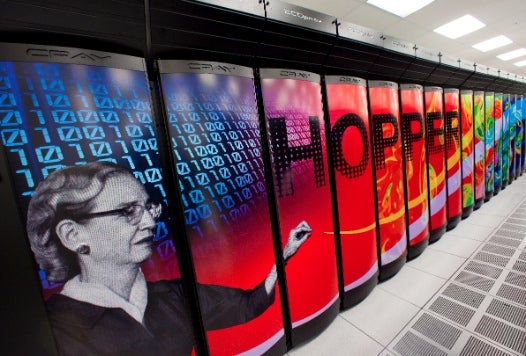Hopper, What Are You Working on Today?
Lawrence Berkeley Labs' biggest energy research resource knows that big science often happens at very small scales--and very high temperatures

_This week, PopSci is peeking under the hood of some of the nation’s biggest and baddest supercomputers–the machines that turn big data into big discoveries, big technologies, and big leaps forward. Over the last week, we managed to get each of the busy machines in this series on the phone to see what they were up to on during a particular day. They were happy to share.
_
Meet Hopper.
Name: Hopper (National Energy Research Scientific Computing Center, Lawrence Berkeley Lab)
TOP500 Rank: 8
Vital Stats: System: Cray XE6 supercomputer. Theoretical peak performance: 1.3 petaflops (1.3 quarillion calculations per second). Inside: 153,216 compute cores connected by a very fast interconnect. Supported by a High Performance Storage System where users archive their data. The HPSS system has a peak capacity of 59 petabytes. On Oct. 26, some 98,750 files were transferred into or out of the HPSS system.
Date: October 27, 2011
What Are You Working On?
- Simulating large-scale particle-in-cell laser plasma interactions relevant to inertial fusion reactions. In English, this involves modeling a fusion reaction in which a fuel target, typically a pellet of deuterium or tritium, is compressed by high-energy beams. Understanding this reaction is key to building the kind of fusion reactor that very well may power the future with cheap and abundant energy, and it’s much easier modeled on Hopper than in the lab. Temperatures in these kinds of plasma reactions are nearly as hot as those on the sun.
- Benchmarking. Supercomputers like Hopper are so powerful that sometimes the team at NERSC and other supercomputing labs have to step back and run tasks solely for the purpose of understanding their computers better, and thus how they can be best used for applications of interest to the scientists who work on the computer. Today Hopper is spending a small portion of its own computing power to test that computing power. It’s an important job that every supercomputer must to do to ensure that it’s working at optimum performance levels, and that its cores are being put to the best possible use.
- Supernova simulations. Ever wonder what it’s like when a star explodes? So does Hopper. Today researchers are running models of supernovae to better understand the mechanisms by which stars die their fiery deaths, and thus seed the universe with nearly all of its heavy elements. And with their massive luminosity, supernovae often serve as “standard candles”–points of reference across the cosmos by which astronomers measure both distances and the rate of expansion of the universe. NERSC calculations back in the 1990s played a central role in this year’s Nobel Prize in physics, awarded for the discovery that our universe is not only expanding, but accelerating. That opens a whole new can of worms regarding the nature of the dark energy supposedly driving that acceleration. Hopper continues to explore these questions today.
- More plasma/fusion science. The Plasma Science and Innovation Center is an academic collaboration that seeks to enable better simulations of confinement devices that can feasibly contain a high-energy fusion reaction here on Earth, thus providing cheap and super-clean energy for all. Of course, this isn’t easy (see above regarding temperatures nearing that of the sun). Fusion energy is a technological holy grail, and today Hopper is on the hunt for it.
- Looking into the fundamental nature of the atom. More specifically, Hopper is taking a deeper look at the nucleus and quantum chromodynamics, a theoretical framework that describes the basic architecture of the atomic nucleus and the bonds that hold protons and neutrons together (known as the strong force). If like charges repel one another, why doesn’t a nucleus composed of positively charged protons tear itself apart? How do quarks and gluons hold themselves together to form protons in the first place? This is envelope-pushing nuclear physics, happening right here and right now.
Catch up with more supercomputers here.